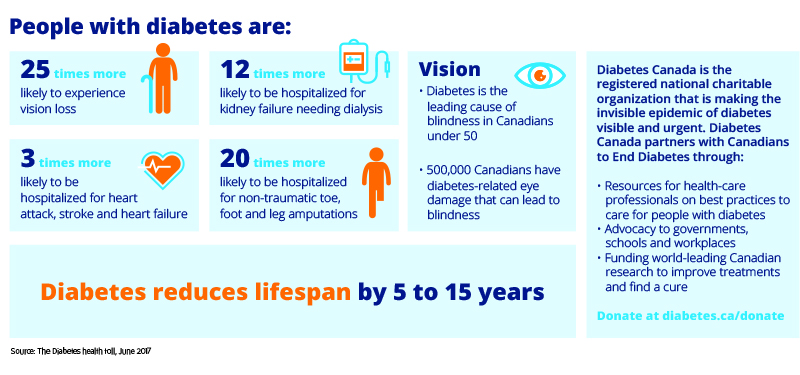Diabetes 360°: RECOMMENDATIONS TO ease the burden of diabetes on all Canadians
Research shows that individuals alone cannot address the diabetes epidemic. While there are many things those with or at risk of the disease can do to increase their chances of a long and healthy life, research proves that it is very difficult for them to succeed without the right environment, education and community-based support. “The fact that Canada is late to adopt a national strategy puts us in the lower third of developed countries,” says Kimberley Hanson, Diabetes Canada’s director of federal affairs. “We believe it’s time that changes.”
“
We want as many Canadians as possible to speak out in support a national strategy because we believe it is the only way we’re going to tackle a problem of this size.”
The numbers support that belief: the number of people diagnosed with diabetes has increased by 50 per cent over the past 10 years, and if current trends continue unchecked, will grow by another 40 per cent in the coming decade. It will cost Canada’s economy $27-billion this year – an enormous burden.
Over the past year, Diabetes Canada brought together more than 120 stakeholders, clinicians, experts and people with diabetes who worked together to develop the Diabetes 360° recommendations. “The approach is based on a proven model that was used successfully in HIV/AIDS. It’s not something that we made up and are hoping will work – we know it will work. We just have to all get behind it,” Ms. Hanson adds.
Building on the best of earlier initiatives, Diabetes 360° has an even greater focus on primary prevention, which means creating an environment that prevents the development of diabetes, she says. “It also has a greater focus on delivering care via telehealth and virtual health technologies, so that even people living in remote and rural areas have access to quality care. As importantly, all of the interventions implemented will be measured in terms of how they are improving patient health.”
Marilee Nowgesic, executive director of the Canadian Indigenous Nurses Association and one of the expert participants, sees the initiative as a way to build authentic, effective relationships with cultures and communities that are at genetically higher risk. In Indigenous communities, she says, “there are many programs, but something is getting lost. This initiative creates an environment that allows Indigenous partners to participate meaningfully in recommendations that relate directly to Indigenous realities. It is a great example of developing a collective leadership approach to ultimately be effective within the respective stakeholder groups.”
Food security, while a primary issue, is only one aspect of the challenges Indigenous people face, she adds. “The reality is that the items and care required are not available or cannot be afforded by most households. The absence of foot care clinics, even care for infection of insulin injection sites, means that treatable complications become the cause of amputations. It would be easy to say, ‘go to the nursing station,’ but sadly they don’t have the supplies,” says Ms. Nowgesic.
Diabetes 360° aims to support people of all cultures and incomes in getting the recommended 150 minutes of moderate to vigorous physical activity every week – something that can be very difficult for families who don’t live in walkable neighbourhoods and can’t afford gym memberships. Diabetes 360° initiatives will also help ensure that people with prediabetes can access the Diabetes Prevention Program, a rigorously researched program that prevented diabetes in almost 60 per cent of participants at high risk of diabetes.
For those living with the disease, Diabetes 360° will mean more consistent and seamless access to quality medical care, along with community-based support, advice and programs that can help them manage their health day-to-day. In addition, it will result in equitable access to the medication, devices and supplies on which they rely.
“The diabetes epidemic is a runaway train right now,” says Ms. Hanson. “We want as many Canadians as possible to speak out in support a national strategy because we believe it is the only way we’re going to tackle a problem of this size. The more voices that we have speaking in unison on an issue, the more it’s likely to be heard by our policy-makers.
“We’re asking every Canadian to consider going to diabetes.ca to quickly and easily send an email to their MP. It’s a step every person can take to help ensure that the recommendations in this strategy are implemented by our government, and this epidemic is addressed.”
TAKE ACTION
Help end the diabetes epidemic in Canada by contacting your MP through:
www.diabetes.ca/strategy
DIABETES 360°
Diabetes Canada’s epidemic response strategy proposes the following targets:
90%
of Canadians live in an environment that promotes wellness and prevents the development of diabetes;
90%
of Canadians know whether they’re at risk for or are living with diabetes;
90%
of those with prediabetes or diabetes receive the appropriate support, or interventions, to avoid developing diabetes or its complications, so that:
90%
achieve improved health outcomes with interventions.
For more related to this story visit globeandmail.com


